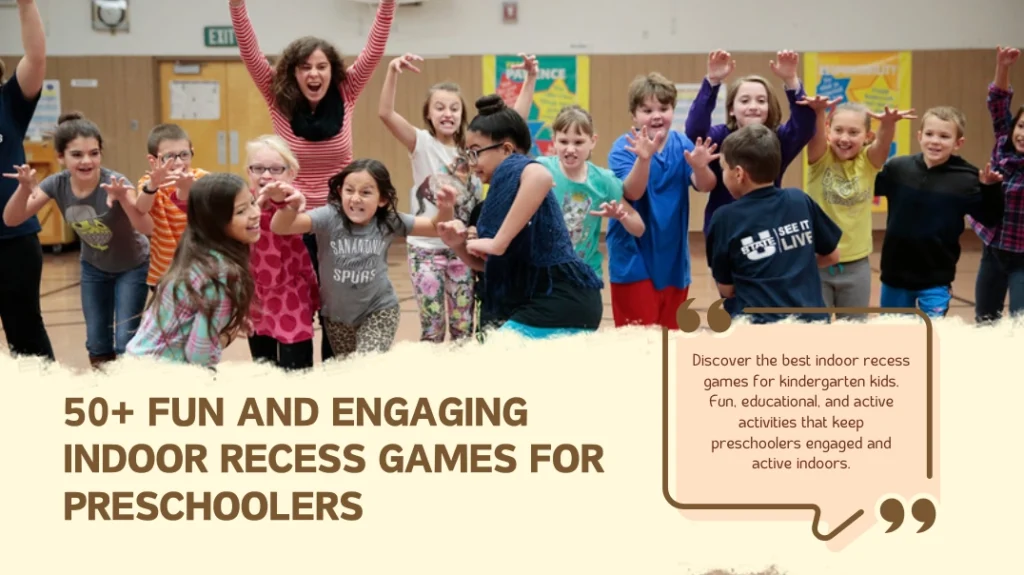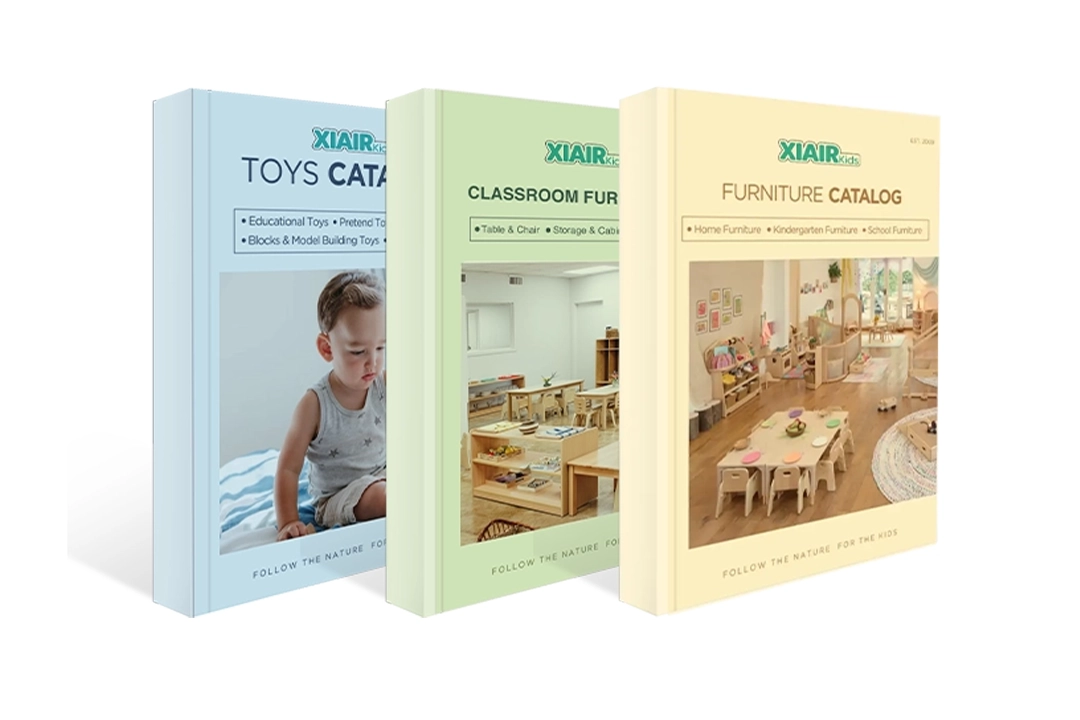Indoor recess games are essential for kindergarten classrooms, especially on rainy or snowy days when outdoor play isn’t possible. Finding engaging and suitable activities for young children can be difficult for a teacher or parent. Traditional recess games, like running around or playing tag, are often out of the question indoors. Keeping kindergarteners active and entertained without access to outdoor space is a challenge many face.
Children need time to move and engage, but indoor recess sometimes feels rushed or chaotic. Without the right games, kids can become restless or disengaged. Finding fun and simple indoor recess games that help develop their physical, social, and cognitive skills is a constant struggle. It’s about burning off energy and ensuring they have meaningful, educational experiences during these breaks.
Fortunately, there’s a solution. Kids can enjoy their break time while improving essential skills with the correct set of indoor recess games for kindergarten. From active indoor recess games to educational and quiet activities, there’s something for every child. These fun games offer opportunities to enhance learning, build social skills, and improve motor coordination. Whether you’re searching for board games for indoor recess, active games, or even online indoor recess games, you’ll find the perfect activities to turn indoor recess into an enjoyable and valuable experience for everyone.
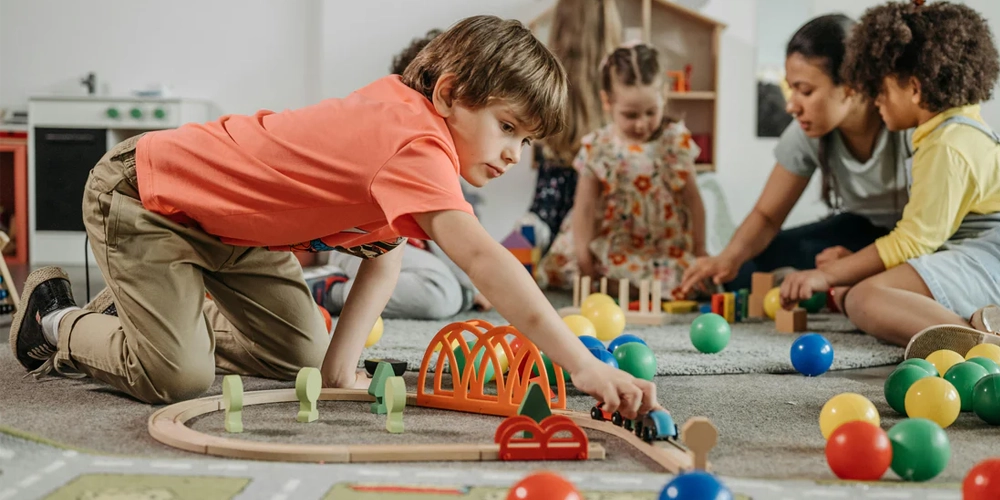
What is Indoor Recess?
Indoor recess refers to break time that happens indoors, typically when outdoor play is impossible due to bad weather or other reasons. It’s an opportunity for children to take a break from structured learning, engage in some physical activity, and interact with their peers in a more relaxed environment. For kindergarteners, indoor recess might involve simple games, arts and crafts, or even quiet activities that help them refresh and recharge before returning to the classroom. These moments of play are essential, as they provide the mental and physical reset young children need to remain focused and active during the school day.
Importance of Indoor Recess
Indoor recess plays a vital role in the daily routine of young children, especially in a kindergarten setting. When children are confined to the classroom due to weather, providing a space to move, engage with their peers, and even learn through play is crucial. Indoor recess isn’t just about keeping kids occupied; it significantly benefits their development. It allows them to burn off the energy necessary for maintaining focus in class. Moreover, these activities provide opportunities for social interaction, building teamwork, and practicing essential skills like sharing and turn-taking.
As much as physical activity is essential for children’s health, mental breaks also play a crucial role in helping children process information and emotions. Young children may struggle with focus and behavior without proper breaks, making indoor recess a critical part of their day.
Why is Recess Important for Kindergarten Kids?
Recess is not just a break from learning; it’s a vital part of young children’s development, especially for preschoolers. It offers numerous benefits that contribute to their growth, including physical, mental, social, and emotional development. Here’s why indoor recess is so important for young children:
- Promuove lo sviluppo fisico
During recess, kids engage in physical activities that help them develop motor skills, coordination, and strength. Whether running, hopping, jumping, or playing simple games, these activities support extensive muscle development and improve balance and coordination. These physical skills are essential for their overall health and help build the foundation for fine motor skills, such as hand-eye coordination and the ability to grip a pencil for writing. - Mental Health and Emotional Regulation
Recess gives children a much-needed mental break. It allows them to shift their focus away from the structured classroom environment and relax, helping them manage stress and anxiety. This downtime is crucial for emotional regulation, allowing kids to recharge before returning to their lessons. Children can reduce frustration or overwhelm by participating in games and activities and return to class feeling more focused and calm. - Migliora le abilità sociali
Recess is an essential time for kindergarteners to interact with their peers. Whether playing indoor recess games or chatting, children practice social skills like sharing, taking turns, and working together. These interactions teach kids how to resolve conflicts, negotiate rules, and communicate effectively, which are vital for building healthy relationships. These skills will serve them well in and out of the classroom as they grow. - Boosts Creativity and Problem-Solving
Playtime, especially during recess, encourages children to use their imagination and creativity. Whether pretending to be animals in a game or solving puzzles, kids use their creativity to engage with the world around them. This imaginative play also fosters problem-solving skills as children learn how to work together, build structures, or even navigate an obstacle course. - Increases Focus and Learning Ability
Indoor recess is also crucial for academic success. By allowing children time to move and play, recess helps reset their brains and prepare them for learning. Studies show children can return to lessons after a break with increased focus and attention. Physical activity helps stimulate the brain, making it easier for kids to concentrate and retain information during class. - Teaches Self-Regulation and Independence
Recess also teaches children how to manage their time and make decisions independently. During play, kids decide which games to play, how to organize their activities, and how to collaborate with others. These choices help children build independence and learn self-regulation, as they are responsible for their actions and behavior during unstructured time.
In conclusion, indoor recess is more than just a break; it is a critical component of a child’s growth. It supports physical health, emotional well-being, social development, creativity, and academic performance. For kids, recess provides a well-rounded foundation that helps them thrive inside and outside the classroom.

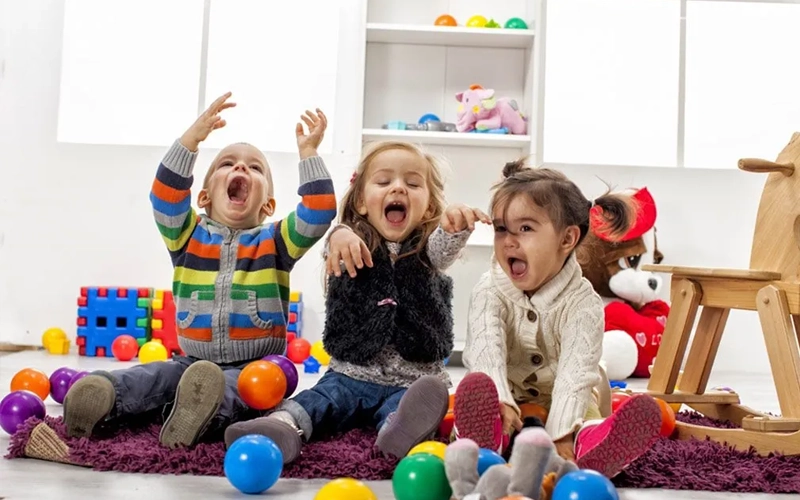
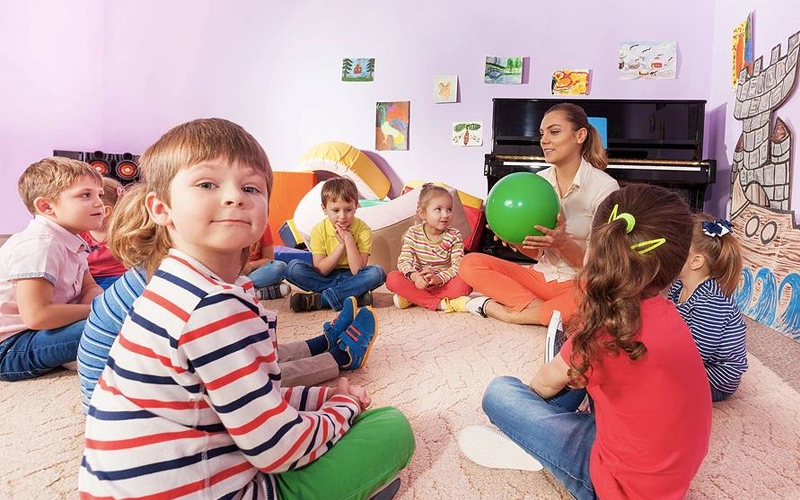
Fun and Simple Indoor Recess Games for Preschool
When indoor recess arrives, it’s essential to have various simple games ready to keep your preschool and early learning students entertained and engaged. These indoor recess games are fun and allow children to release their energy while developing essential skills like coordination, listening, and social interaction. Whether you’re in a kindergarten, daycare, or any other early childhood setting, these games are easy to implement and require minimal preparation.
1. Simon Says
“Simon Says” is a classic game that works well for children in preschool and kindergarten. In this game, one child (or the teacher) gives commands like “Simon says jump!” or “Simon says clap your hands,” and the children must follow only if the command starts with “Simon says.” If the leader doesn’t say “Simon says,” and a child follows the command, they are out. This game is fantastic for helping kids develop their listening skills and practice following directions, which is crucial in any early learning environment.
2. Freeze Dance
Another favorite indoor recess game for preschool and daycare kids is Freeze Dance. Play some fun music and let the children dance however they want. When the music stops, they must freeze and hold their position. The game helps improve balance, focus, and coordination as children work on staying still when the music pauses. This game is a fun and active way to engage kids and keep them moving, especially when they can’t go outside for outdoor play.
3. Hot Potato
Hot Potato is a simple but highly effective game for young learners. Children pass a soft object (like a ball or stuffed toy) around the circle while music plays. When the music stops, the child holding the object is out. This game encourages fast reflexes, social interaction, and team participation. It’s one of the best indoor recess games for daycare and early learning centers to keep kids engaged while promoting physical activity.
4. Follow the Leader
“Follow the Leader” is an excellent game for developing coordination and encouraging creativity. In this game, one child takes the lead and performs actions like hopping, skipping, or stretching. The other children must follow along and mirror the leader’s movements. This game is fantastic for developing physical skills like balance and coordination while allowing children to have fun in a group setting.
5. Bean Bag Toss
A classic favorite, Bean Bag Toss is perfect for children in preschool or kindergarten. Set a target (like a basket or hula hoop) and challenge the kids to toss bean bags. This game is excellent for improving hand-eye coordination and providing practice with throwing skills. It’s simple but engaging and easily adapted to suit different ages and skill levels.
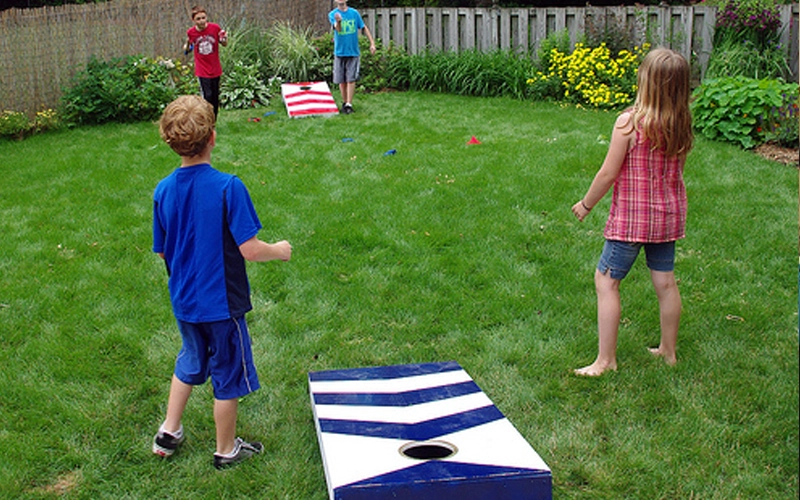
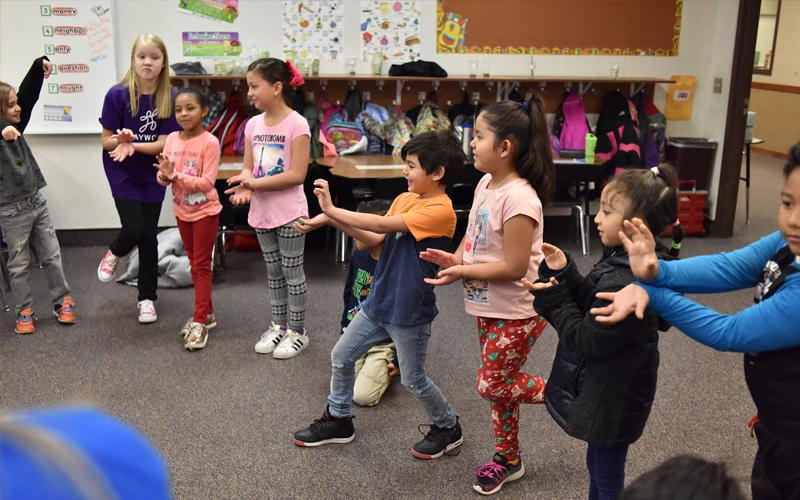
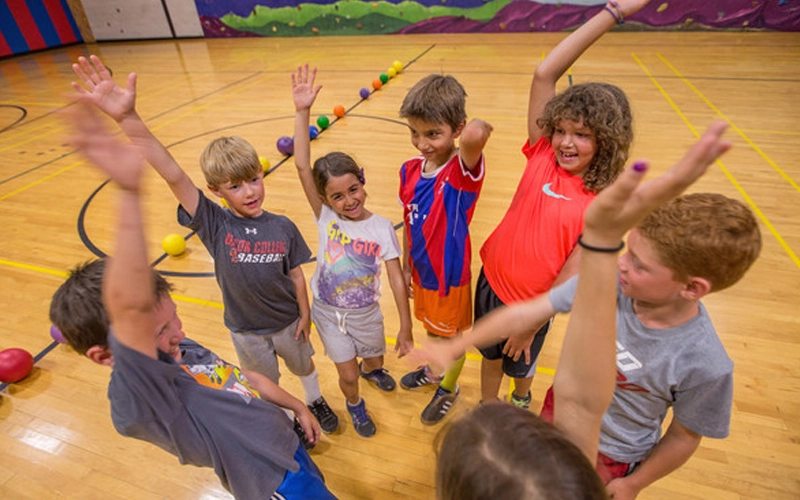
6. Color Hop
Color Hop is a fun and active game that reinforces color recognition while giving children a chance to move. Place colorful mats or pieces of paper around the room and call out a color. The children must hop to the correct color. This game is perfect for early learning environments where kids still master basic colors and need opportunities to practice coordination and movement.
7. Mirror Game
In the Mirror Game, one child makes movements (like jumping, spinning, or waving), and the others must mirror those movements exactly. It’s an excellent way for children to develop their focus and coordination while encouraging creativity. This game is perfect for preschoolers developing motor skills and learning about body control.
8. Balloon Pop Relay
This game adds an element of surprise and will keep the children entertained. Write tasks (like “jump 5 times” or “spin around”) on a balloon, and then pop the balloon as the children complete the task inside. This game combines physical activity with excitement and lets kids burn off some energy while working together.
9. Animal Walks
In Animal Walks, kids mimic the movements of different animals, such as hopping like a frog, waddling like a penguin, or crawling like a bear. This game helps strengthen their gross motor skills while encouraging imaginative play. It’s a fun way for preschoolers and kindergarteners to practice movement and coordination entertainingly.
10. Musical Chairs
Musical Chairs is always a crowd-pleaser, especially for children in preschool and kindergarten. Set up chairs in a circle and play music while the children walk around the chairs. When the music stops, they must quickly find a chair. The child left standing is out. This game teaches children about timing, reflexes, and following rules in a group.
These fun indoor recess games keep children in daycare, preschool, and early learning centers engaged and active while learning through play. Each game helps improve physical skills, social abilities, and emotional regulation, making it ideal for children.
Non limitarti a sognarlo, progettalo! Parleremo delle tue esigenze di arredamento personalizzato!
Active Indoor Recess Games for Kindergarten
For days when children can’t go outside for outdoor play, active indoor recess games are a great way to keep preschoolers, kindergarteners, and young learners engaged and active. These games help children burn off energy, develop motor skills, and improve coordination, all while keeping them entertained and involved with their peers. Here are some exciting indoor recess games to keep your students moving and having fun!
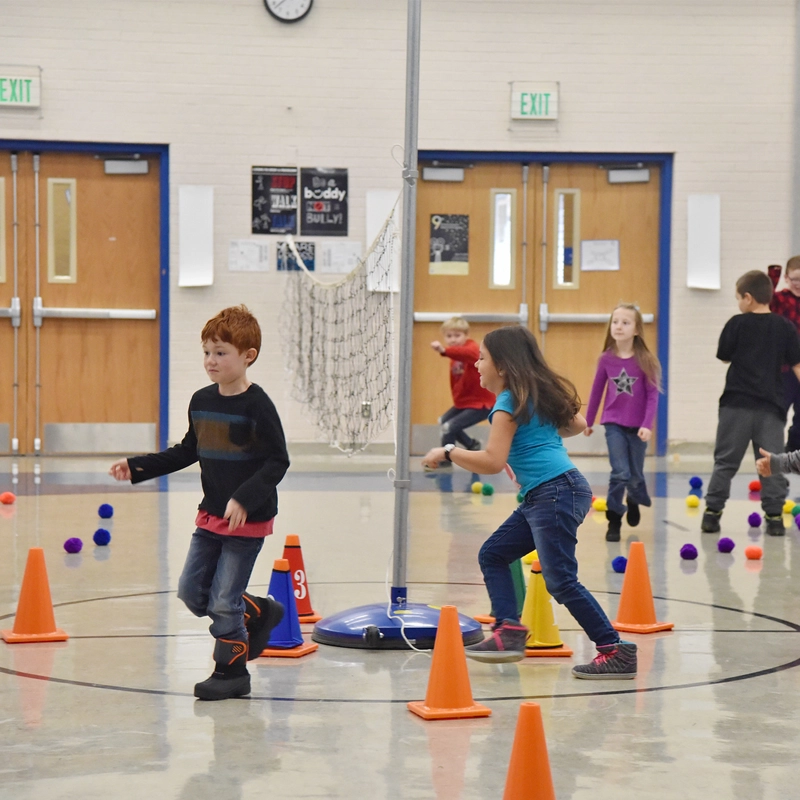
1. Indoor Obstacle Course
Set up a fun and safe indoor obstacle course using classroom furniture and other available materials. Kids can crawl under tables, jump over cushions, and balance on tape lines. This game enhances children’s physical strength, agility, and balance and encourages problem-solving as they navigate the obstacles. It’s one of the best indoor recess games for getting kids moving creatively and energetically!
2. Balloon Volleyball
Balloon volleyball is a fantastic, active indoor recess game for kindergarten kids. Instead of using a traditional ball, use a balloon to play volleyball. The lightweight balloon moves slowly through the air, giving children ample time to react and play. This game promotes teamwork, hand-eye coordination, and social skills as children learn to work together to keep the balloon off the ground.
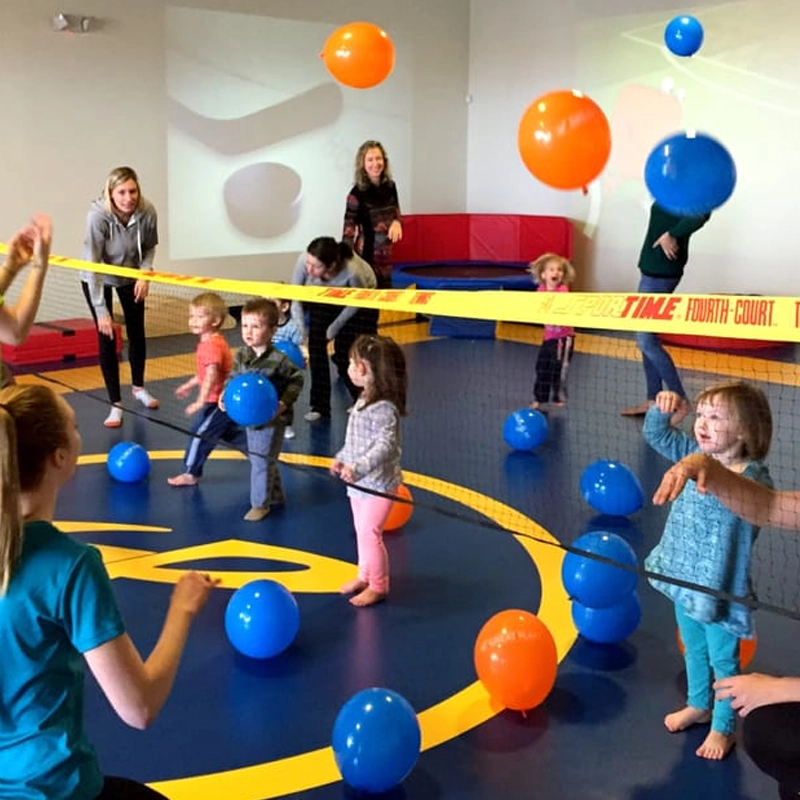
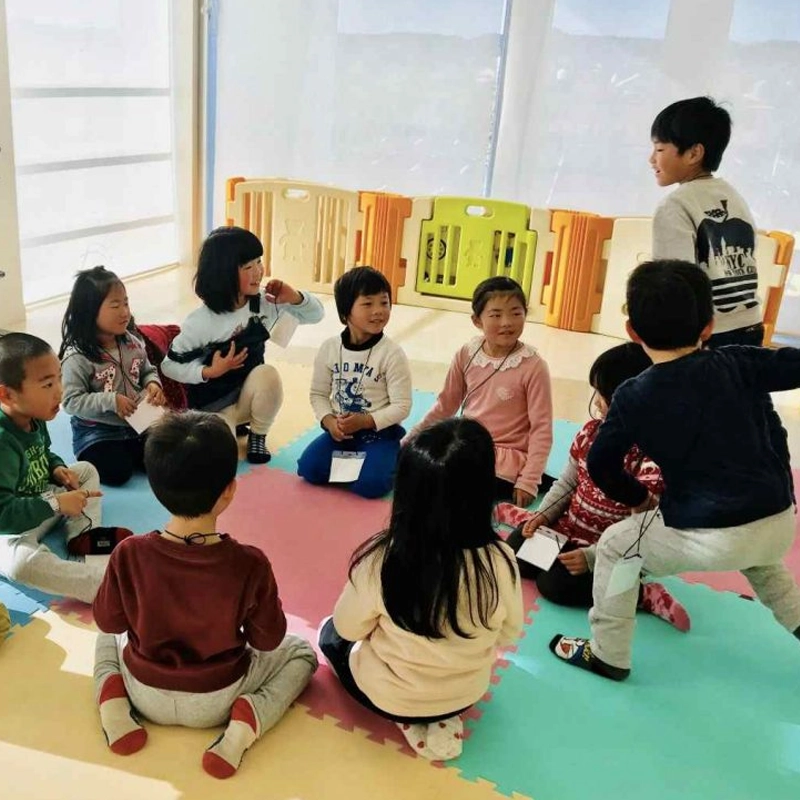
3. Duck Duck Goose
Duck Duck Goose is a classic playground game that can easily be adapted for indoor play. Children sit in a circle, and one child walks around tapping others on the head, saying “duck” as they tap. When the child taps someone and says “goose,” the tapped child jumps up and chases the “it” child around the circle. This game encourages running, quick thinking, and social interaction, making it a fun choice for daycare and preschool.
4. Scavenger Hunt
A scavenger hunt is an excellent game for preschoolers and kindergarteners during indoor recess. Create a list of objects for the kids to find around the room or classroom. They can search for shapes, colors, or specific items you’ve hidden. This game promotes exploration, teamwork, and attention to detail, all while allowing children to get up and move around the room.
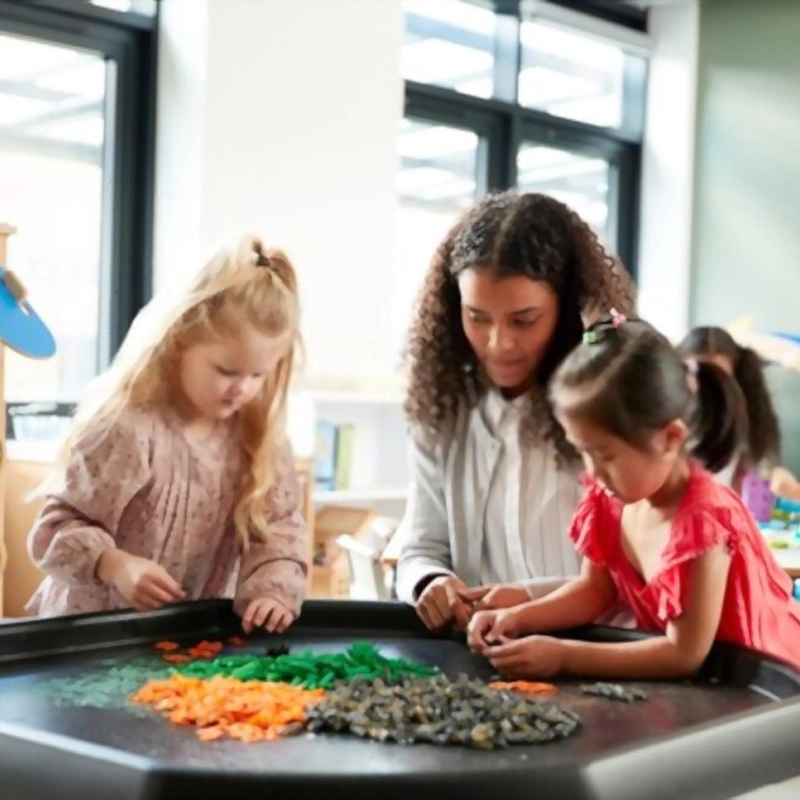
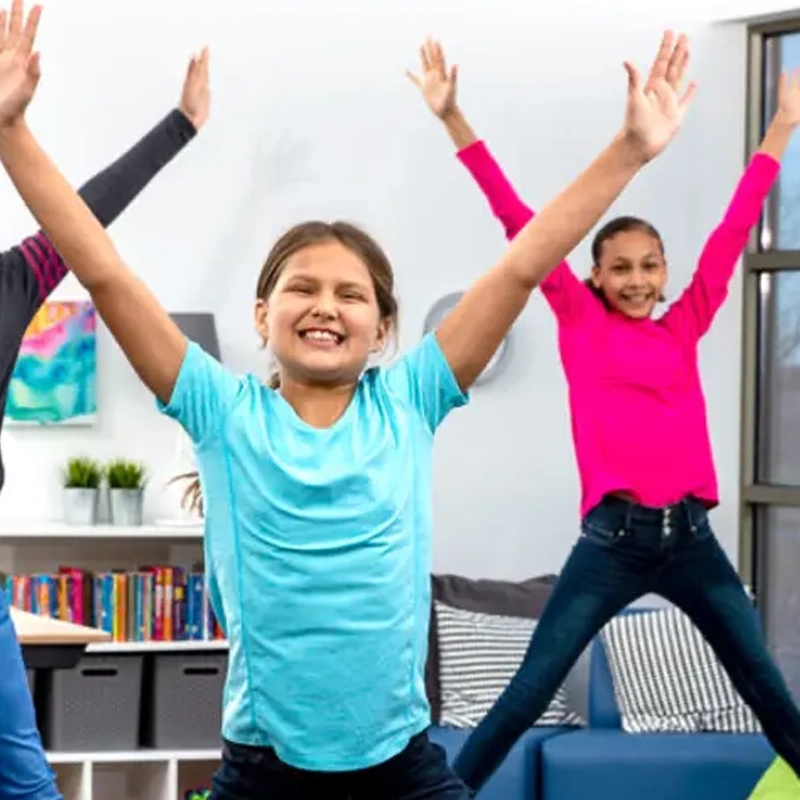
5. Jumping Jacks Challenge
Jumping Jacks are a simple and effective way to get children moving indoors. Challenge them to see how many jumping jacks they can do in one minute. It’s an excellent way to improve cardiovascular health, coordination, and stamina. You can make the game even more fun by creating different challenges for each round, such as “Do 10 jumping jacks, then hop in place 5 times!”
6. Indoor Bowling
Set up an indoor bowling game using empty plastic bottles as pins and a soft ball as the bowling ball. Children can take turns rolling the ball to knock over the pins, which helps improve hand-eye coordination and motor skills. You can make the game more exciting by turning it into a friendly competition or adding bonus rounds where they need to complete a task before they bowl.
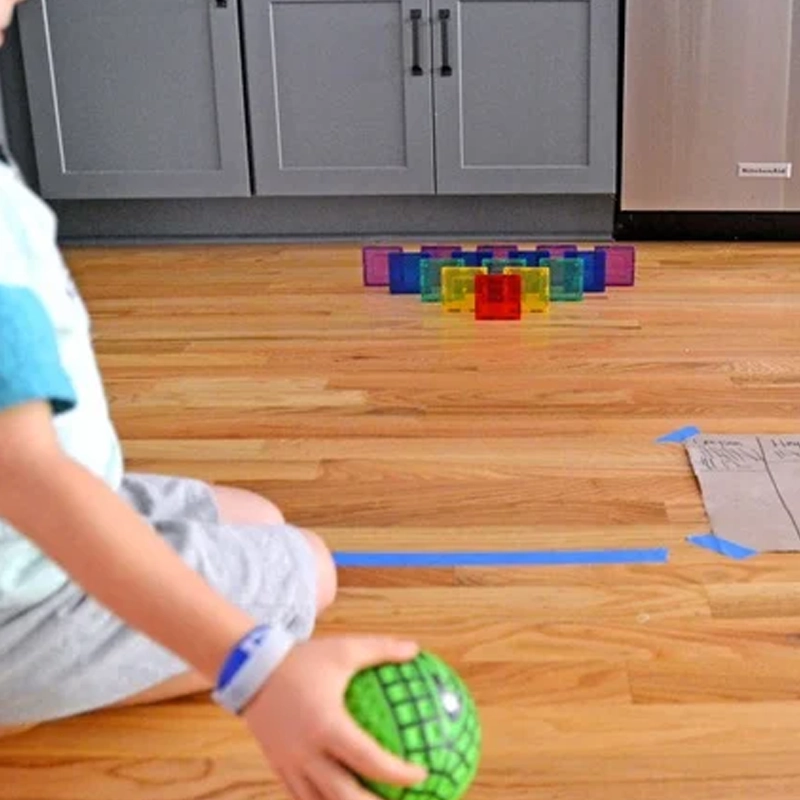
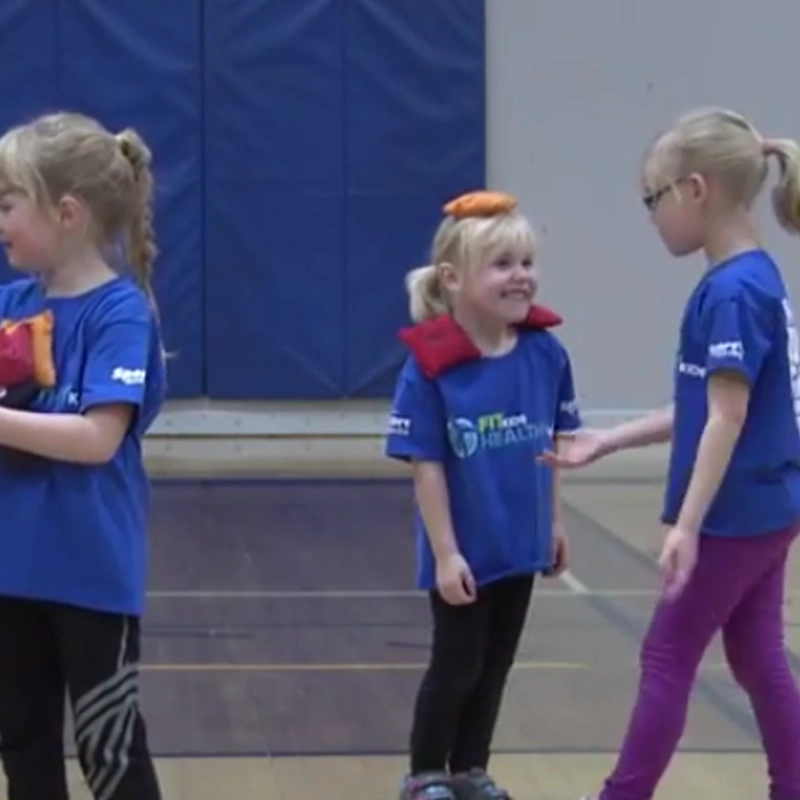
7. Tunnel Crawl Race
Set up a “tunnel” using chairs and blankets, and have children crawl through the tunnel to the other side. This game encourages flexibility, strength, and coordination. It’s a great way to engage preschoolers and kindergarteners, and they’ll enjoy the challenge of navigating the tunnel in a race.
8. Hopscotch (Indoor Version)
Using tape, create a hopscotch grid on the floor. Children can hop from one number to another, practicing balance, coordination, and counting. Indoor hopscotch is an excellent way for young learners to get active while practicing essential number recognition and order.
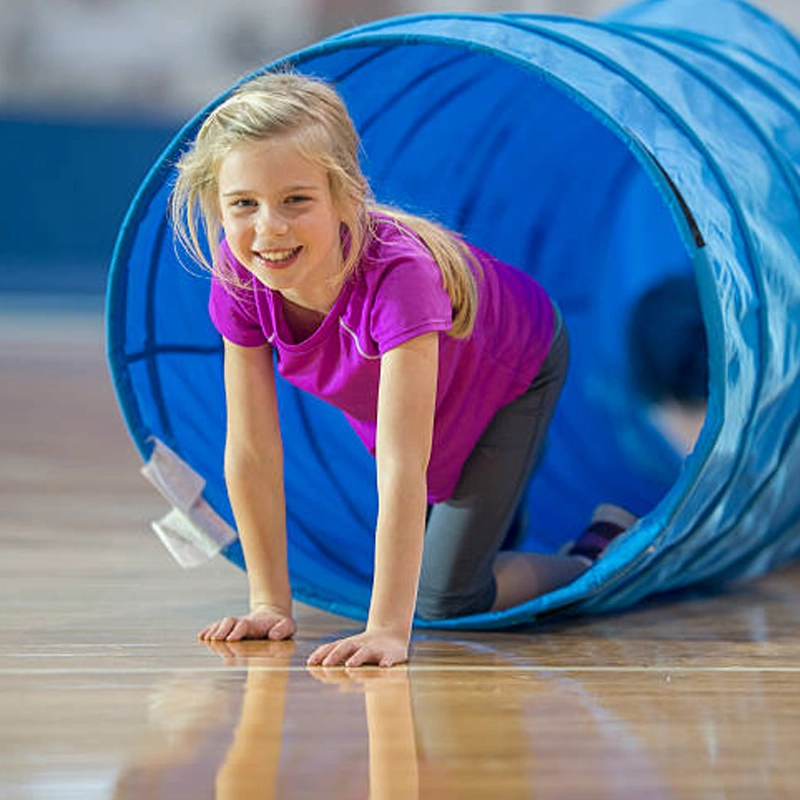
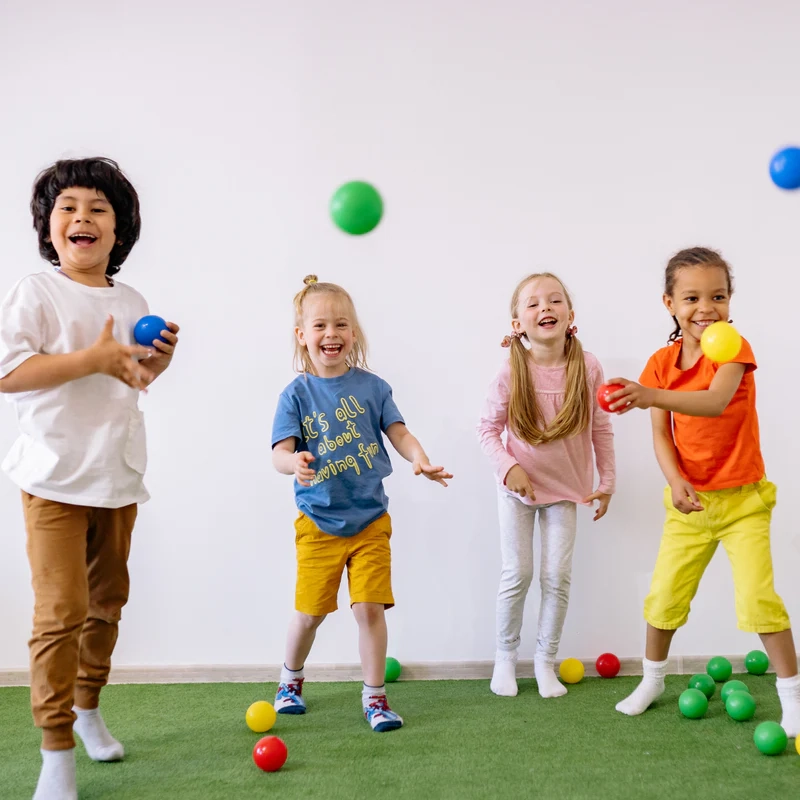
9. Catch the Ball (with Soft Balls)
Children throw a softball at each other in this simple game and practice catching. It helps improve hand-eye coordination and social interaction. This game can be played in pairs or small groups and is adaptable for various indoor spaces, making it a perfect indoor recess game for kindergarten and preschool.
These active indoor recess games are designed to keep children moving and engaged even when outdoor play isn’t an option. They allow kids to release energy and help them develop critical physical skills, teamwork, and social abilities. Whether you’re in a preschool, kindergarten, or early learning center, these games are sure to be a hit with your students!
Educational and Quiet Indoor Recess Games for Kindergarten
When the weather keeps children indoors, educational and quiet indoor recess games provide an excellent opportunity for preschool and kindergarten students to stay engaged while promoting learning. These games encourage concentration, creativity, and problem-solving skills, allowing kids to unwind while learning and practicing essential skills in a calm environment.
1. Puzzle Races
Puzzle races are a great way to engage children while helping them develop problem-solving skills. Kids can race against each other to complete a simple puzzle, improving their cognitive skills and understanding of shapes, colors, and patterns. It’s an exciting yet calm way to entertain children during indoor recess.
2. Memory Games
Memory games are perfect for quiet indoor recess activities. Kids take turns flipping cards to find matching pairs. This game improves memory, focus, and attention to detail while allowing children to work in groups.
3. Story Time & Acting
One of kindergarten’s best indoor recess games is story time, where children listen to a short story and then act it out. This encourages imagination and creativity while also improving language skills and communication. Kids can take turns being storytellers and actors, enhancing their verbal skills and confidence.
4. Alphabet Matching
Alphabet matching games help preschoolers recognize letters and improve letter-to-sound correspondence. You can use flashcards with uppercase and lowercase letters and have children match them. This game promotes literacy skills and is an excellent activity for early learning centers.
5. Shape Sort
In the shape sort game, children are asked to identify and group various shapes. This game helps improve shape recognition, categorization, and fine motor skills. It’s a quiet, educational activity that can be set up easily using blocks or paper shapes.
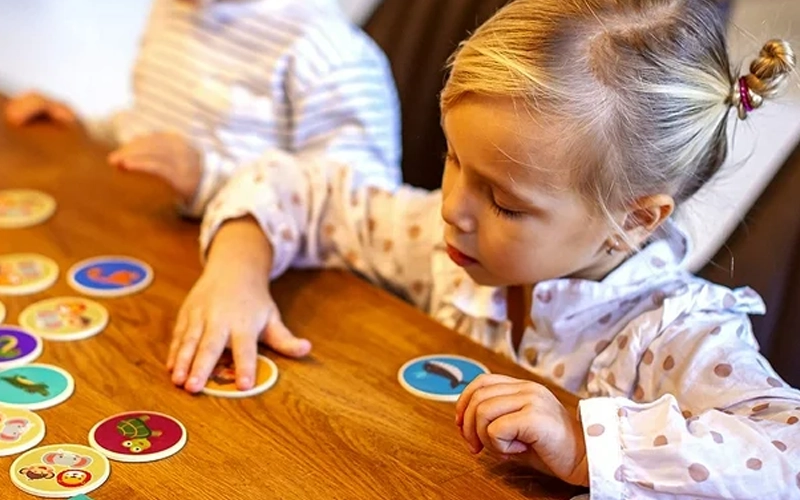
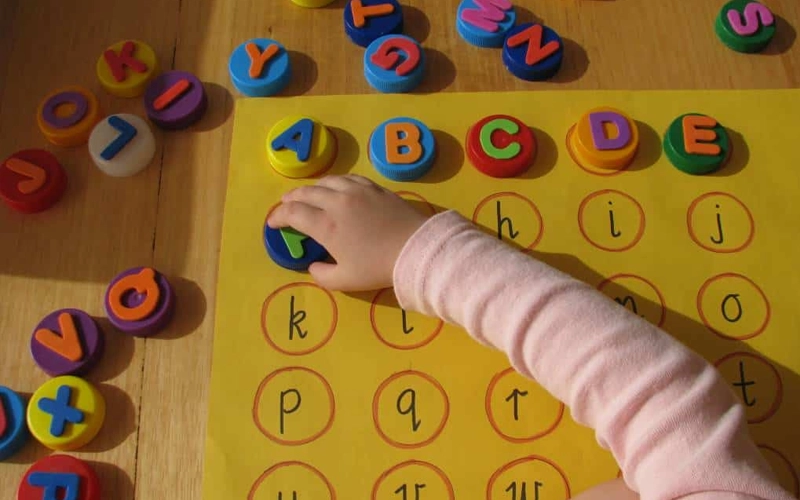
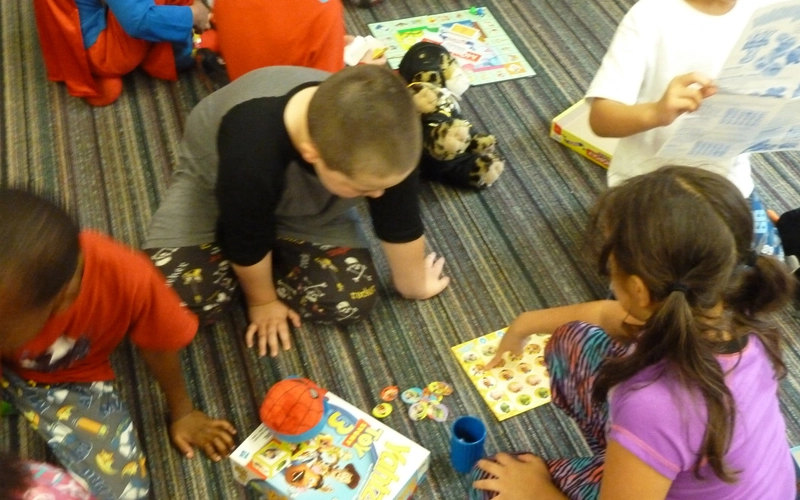
6. Counting Games
Counting games are essential for young children to practice number recognition and sequencing. You can use objects like blocks, buttons, or even your fingers to practice counting from 1 to 10. This is a fantastic indoor recess game for preschoolers and kindergarteners to reinforce early math skills.
7. Rhyming Word Challenge
In the rhyming word challenge, the teacher says a word, and the children try to think of words that rhyme with it. This game enhances phonemic awareness, which is crucial for reading and language development. It’s a quiet and fun way to engage young minds.
8. Color Sorting Game
Color sorting is a quiet and simple game that encourages kids to sort objects by color. This game helps develop fine motor skills, color recognition, and categorization abilities, making it a great choice for preschool and kindergarten students.
9. Guess the Sound
Guess the Sound is a fun auditory game where children close their eyes and listen to a sound (like an animal noise, bell, or musical instrument) and then guess what it is. This game improves listening skills, focus, and memory, all while keeping children calm and engaged.
10. Read-Aloud & Draw
In Read-Aloud & Draw, the teacher reads a short story or passage, and the children draw a picture of what they imagine. This game improves listening, comprehension, and creativity. It’s an excellent activity for kindergarten and preschool kids to develop their listening skills while promoting artistic expression.
These indoor recess games are perfect for preschool, daycare, and early learning centers. They provide a peaceful break from active play while enhancing skills like problem-solving, creativity, and focus. These quiet games offer opportunities for children to grow academically and socially while enjoying the fun of indoor recess.
La tua classe perfetta è a un clic di distanza!
Board Games for Indoor Recess
Board games are another fantastic way to keep kindergarteners, preschoolers, and young learners entertained and engaged during indoor recess. These games are fun and provide valuable opportunities for kids to practice social skills, turn-taking, strategy, and problem-solving. Here are some of the best indoor recess board games that are perfect for children in preschool and early learning centers:
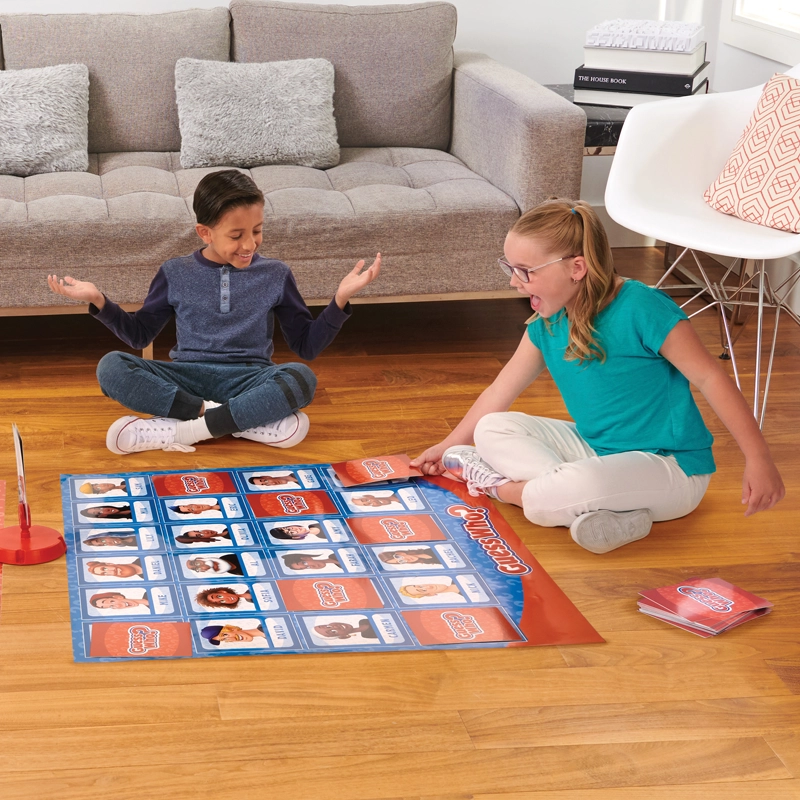
1. Guess Who?
Guess Who? is a simple yet effective game where children ask yes-or-no questions to determine their opponent’s character. This game encourages critical thinking, reasoning, and social interaction, making it an excellent choice for preschool and kindergarten students.
2. Candy Land
Candy Land is a colorful and easy-to-understand board game that teaches kids about colors, numbers, and taking turns. It’s perfect for young children and is one of the most popular indoor recess games for kindergarten and preschoolers.
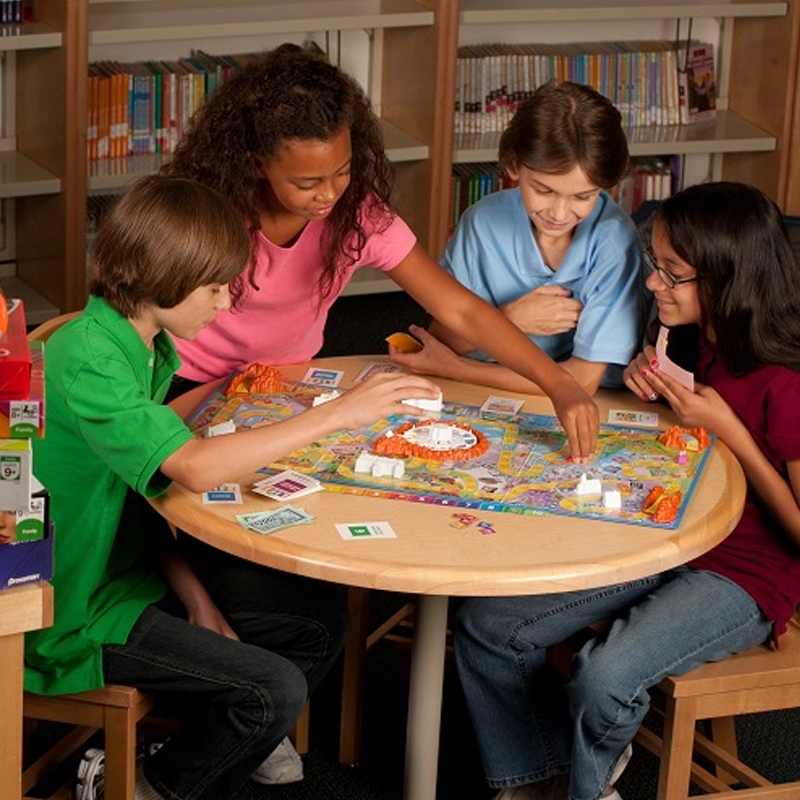
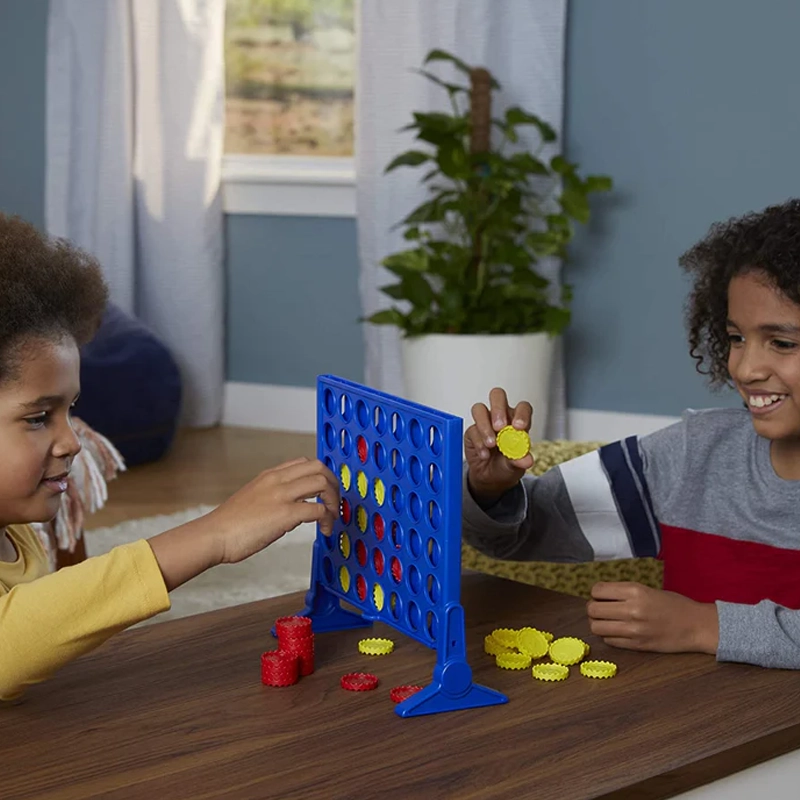
3. Connect Four
In Connect Four, children take turns dropping colored discs into a vertical grid to line up four pieces in a row. This game helps improve critical thinking, strategy, and hand-eye coordination. It’s an excellent option for early learning centers looking to encourage social interaction while playing.
4. Chutes and Ladders
Chutes and Ladders is a timeless game that helps children practice counting and number recognition while navigating the chutes and ladders on the game board. It’s a fun and educational indoor recess game perfect for kindergarten kids.
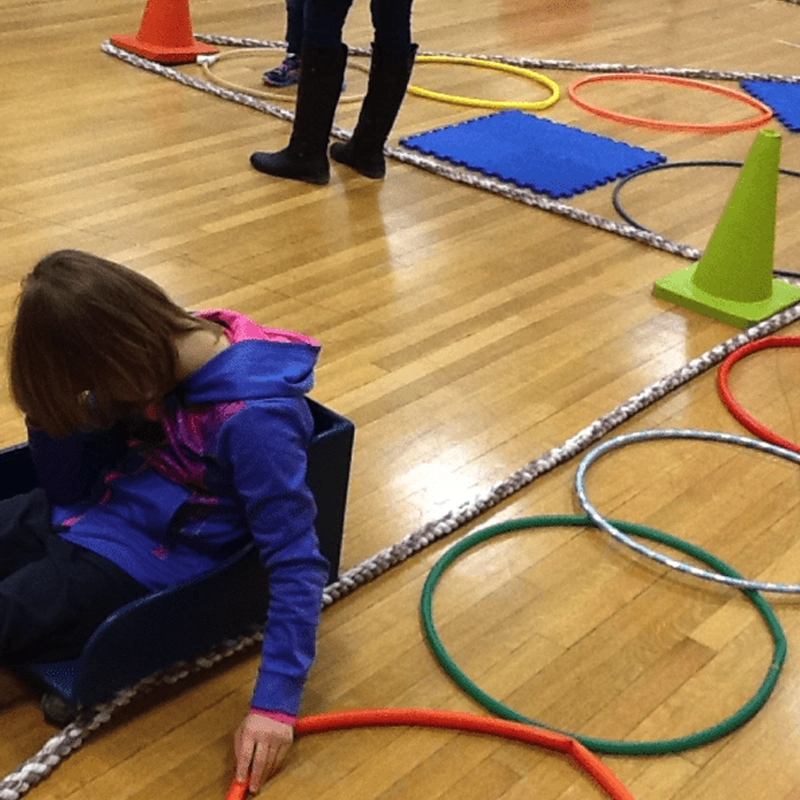
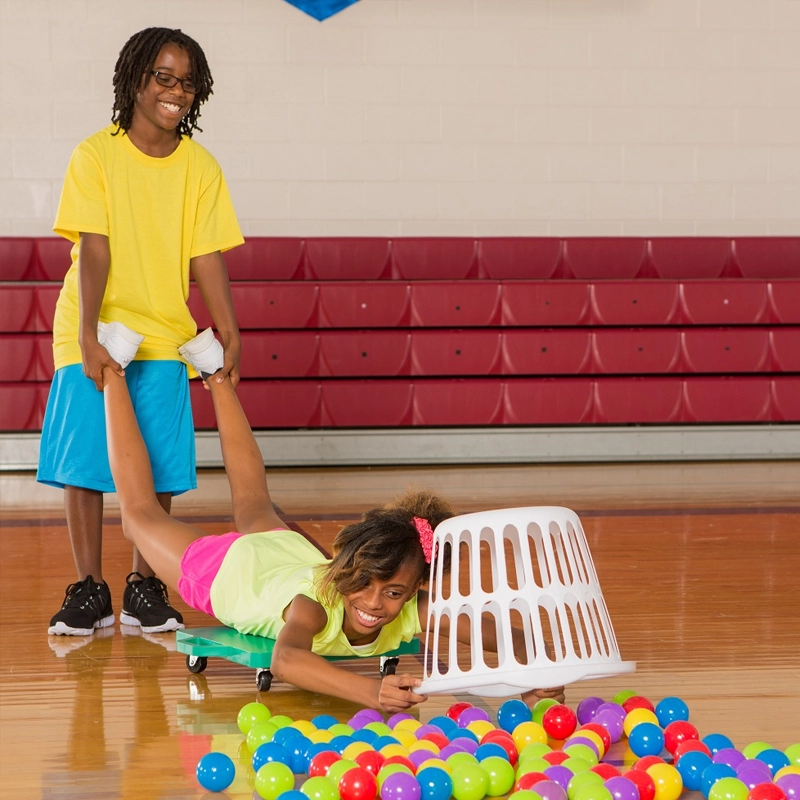
5. Hungry Hungry Hippos
In Hungry Hungry Hippos, kids work together to collect as many marbles as possible by pressing a lever to make their hippo move. This game encourages teamwork, coordination, and friendly competition, making it ideal for preschoolers and kindergarteners.
6. Uno
Uno is a fast-paced card game where children match colors and numbers while trying to be the first to get rid of all their cards. It’s great for teaching children strategy, number recognition, and patience, and it’s always a favorite for indoor recess.
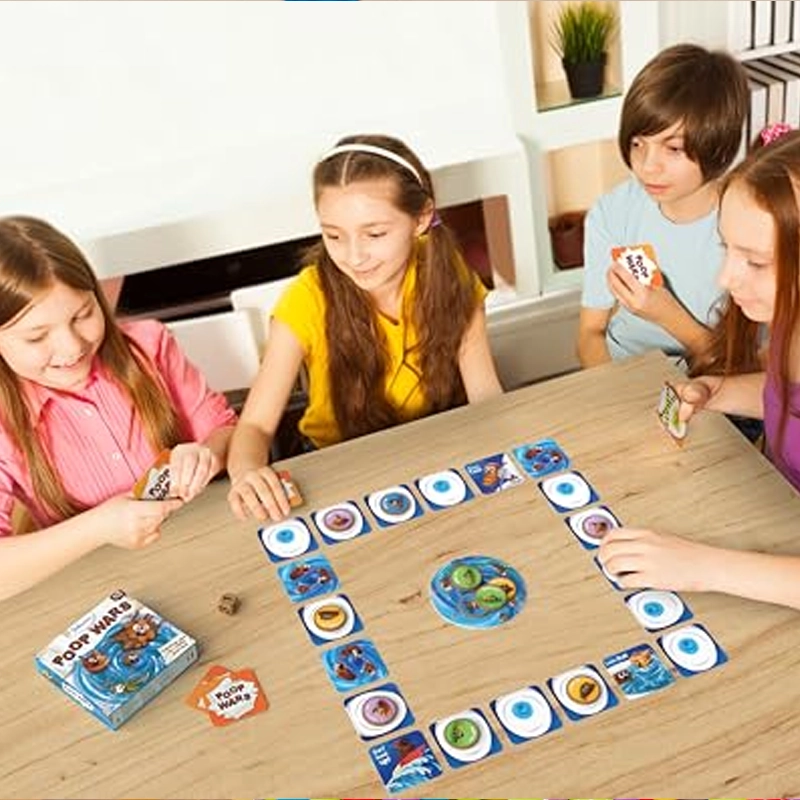
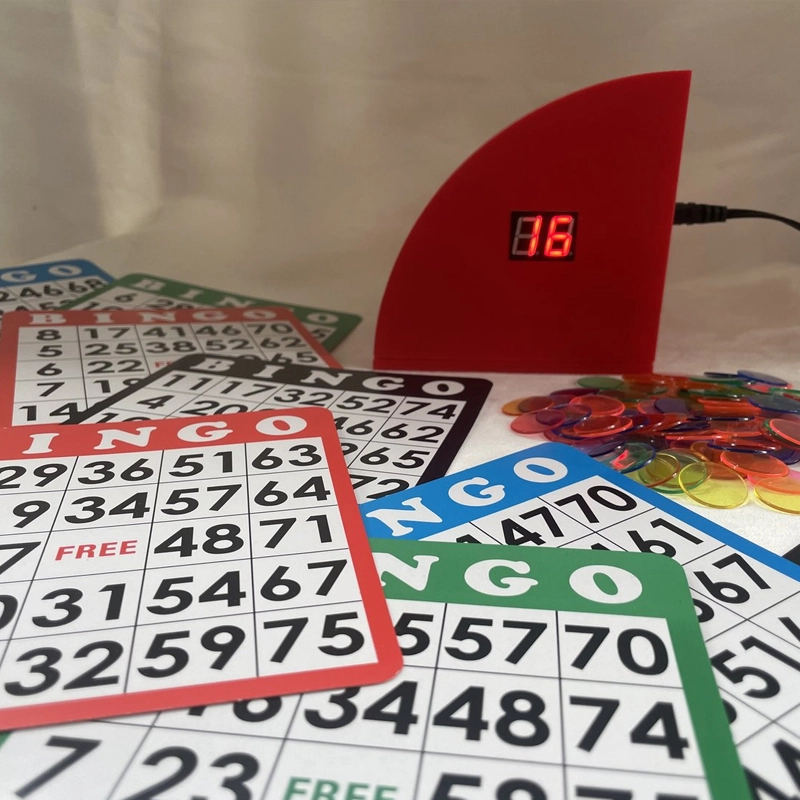
7. Bingo
Bingo is a simple game that teaches children to recognize numbers or words. It’s an excellent indoor recess game for kindergarteners and preschoolers to practice listening skills and number recognition in a fun, competitive way.
8. Guess the Picture
In Guess the Picture, children are shown a series of clues and must guess what the picture is based on the description. This game helps with observation, memory, and language development, making it an excellent choice for early learning centers.
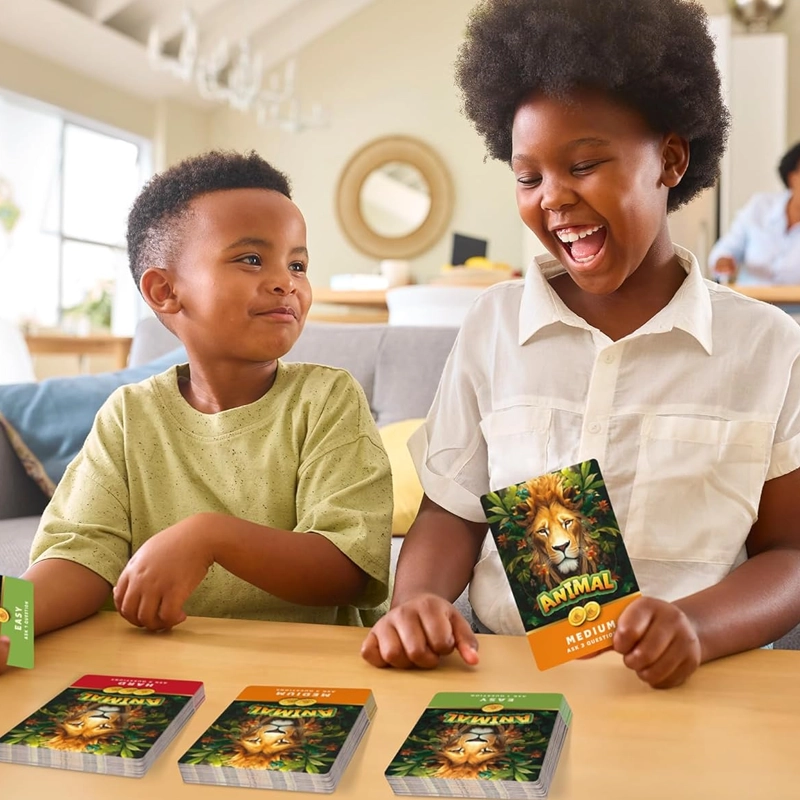
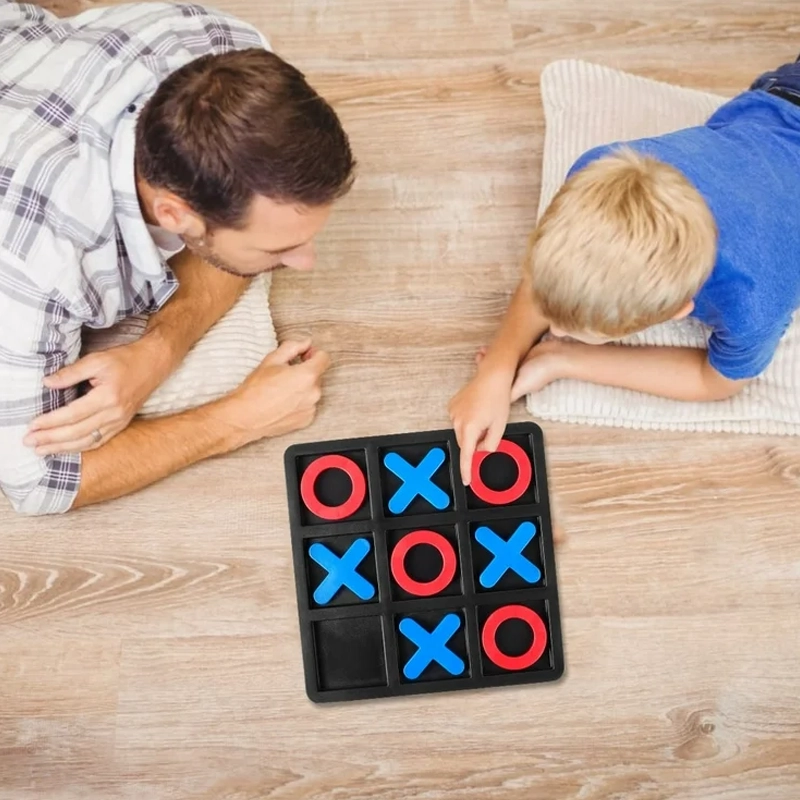
9. Tic-Tac-Toe
Tic-Tac-Toe is a quick and easy game that teaches children how to strategize and think critically. By taking turns placing theirs X’s or O’s on a 3×3 grid, kids learn about patterns, strategy, and fair play.
10. Memory Match
In Memory Match, children flip over cards and try to find matching pairs. This game is excellent for improving memory, focus, and concentration, making it one of preschool and kindergarteners’ best indoor recess games.
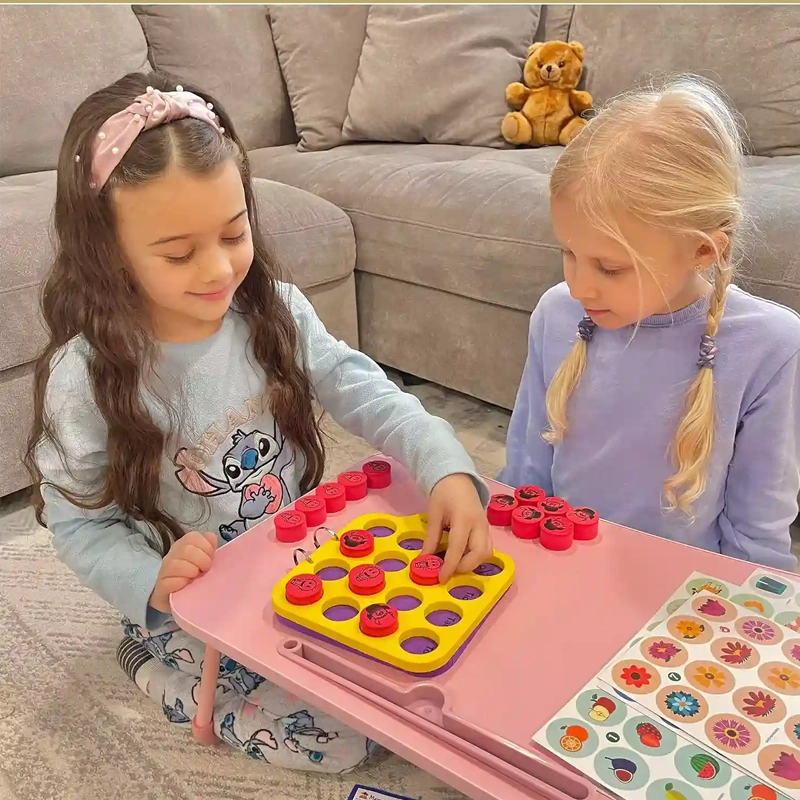
These board games for indoor recess are a great way to combine learning with fun. They help children develop critical cognitive, social, and emotional skills while keeping them entertained. Whether you’re in a preschool, kindergarten, or early learning center, these games will make recess a delightful and enriching experience for all kids.
What Are Some Active Indoor Recess Games for Larger Groups?
Finding indoor recess games that keep everyone engaged and active can be challenging when working with larger groups of young children in kindergarten, preschool, or early learning centers. It’s important to have games that allow kids to move around, interact with each other, and promote teamwork. These active indoor recess games are perfect for larger groups of children, helping them stay energetic and engaged during indoor breaks.
1. Four Corners
Four Corners is an exciting and straightforward game that works perfectly in large groups. One child is selected to be “it” and calls out one of the room’s corners. All other children must run to a corner; they are safe if they choose the correct one. If the caller selects their corner, they are out. This game encourages movement, listening skills, and quick thinking, making it one of the best indoor recess games for larger groups.
2. Pass the Ball
In Pass the Ball, children stand in a circle and pass a ball around while music plays. When the music stops, the child holding the ball must perform a task (like jumping or spinning) before passing it again. This game encourages teamwork and quick reflexes, keeping children actively involved. It’s an easy-to-organize and fun game for large groups.
3. Toss and Catch
Toss and Catch is a simple yet effective game that helps improve hand-eye coordination. Children toss a softball to each other and practice catching. This game can be played in pairs or small groups, making it perfect for indoor recess, especially with larger groups of children. It’s also adaptable for children of different skill levels.
4. Relay Races (Indoor Version)
Relay races are a fantastic way to keep kids active and working together. Set up a simple course within the classroom or hallway, and let kids race from one point to another. They can pass an object (like a baton or beanbag) to the next teammate. Indoor relay races encourage teamwork, physical activity, and a sense of fun, which makes them a perfect fit for large groups.
5. Hide and Seek (Limited Area)
For preschoolers and kindergarteners, a classic game like Hide and Seek works well even indoors. However, to keep things manageable, set boundaries for where the children can hide within the classroom. The seeker counts, and the hiders try to remain silent and hidden until they are found. This game helps with spatial awareness and allows kids to move around during indoor recess.
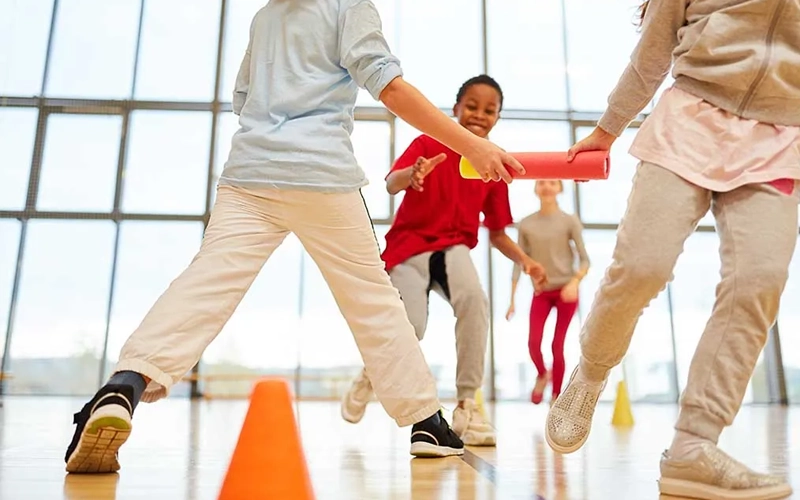
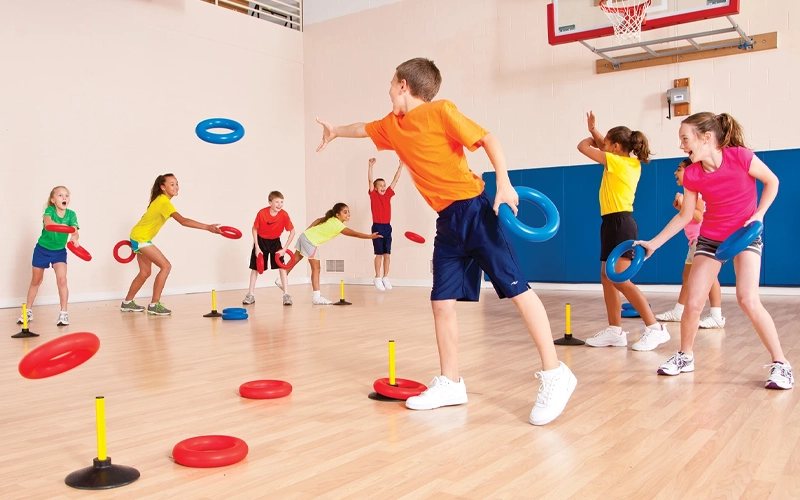
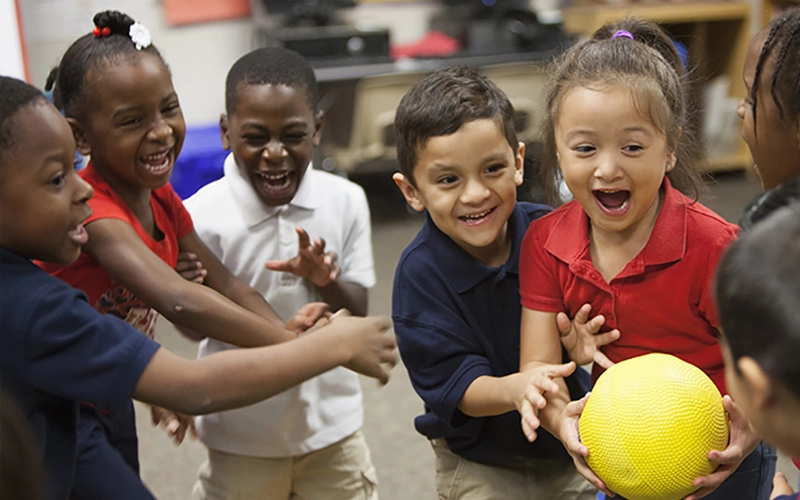
6. Freeze Tag
Freeze Tag is an active and exciting game for large groups. One child is “it” when they tag another child; that child must freeze in place until another child unfreezes them by tagging them. This game encourages running and coordination while promoting social interaction. It’s perfect for indoor recess games for larger groups because it involves everyone, keeping the energy high.
7. Hot Potato with Actions
A twist on the classic Hot Potato: in this version, children must complete a specific action (like spinning or hopping) before passing the object. It’s an excellent game for indoor recess in larger groups, as it keeps everyone moving and engaged. The added challenge of performing actions while passing the object helps kids work on their balance, coordination, and ability to follow instructions.
8. Musical Statues
In Musical Statues, children dance while music plays, but when the music stops, they must freeze in place like statues. If a child moves, they are out. This game promotes body control, balance, and focus and works incredibly well for preschool and kindergarten children. It’s a fun and active game that gets everyone involved, perfect for larger groups during indoor recess.
9. Picture Bingo
Picture Bingo is an easy game that can be adapted for any group size. Children are given cards with pictures instead of numbers and must match the images called out by the leader. This game helps children with recognition skills while allowing them to remain engaged. Picture Bingo is perfect for quieter moments during indoor recess but can also be played in larger groups, making it ideal for kindergarten classrooms.
10. Paper Airplane Race
Paper Airplane Race is a fun way to bring out creativity and competition during indoor recess. Children fold their paper airplanes and race them to see whose plane flies the furthest. It encourages fine motor skills and creativity as kids design and test their airplanes. The game is perfect for larger groups; everyone can participate and enjoy the fun competition.
These active indoor recess games are perfect for kindergarten, preschool, and early learning centers with a larger group of children to manage. They keep the kids moving, improve their physical skills, and foster teamwork and social interaction—all while making indoor recess enjoyable and engaging.
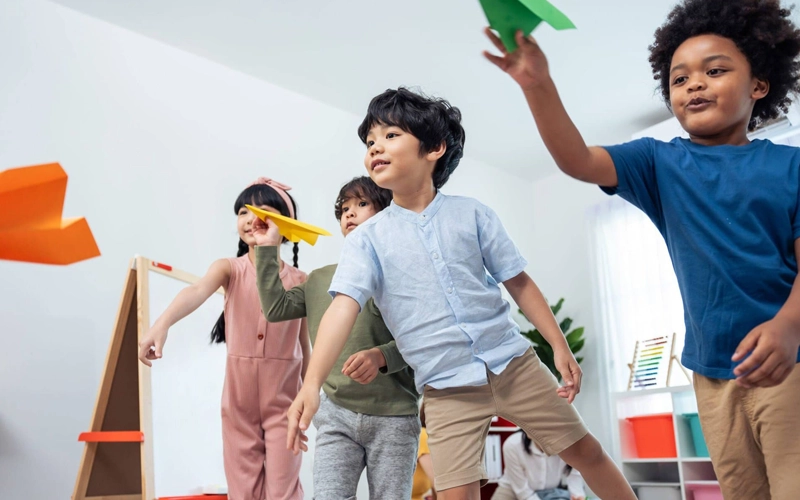
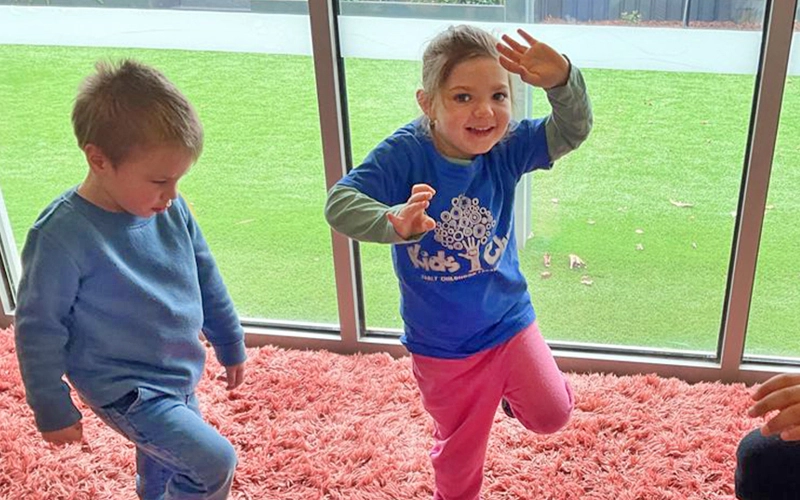
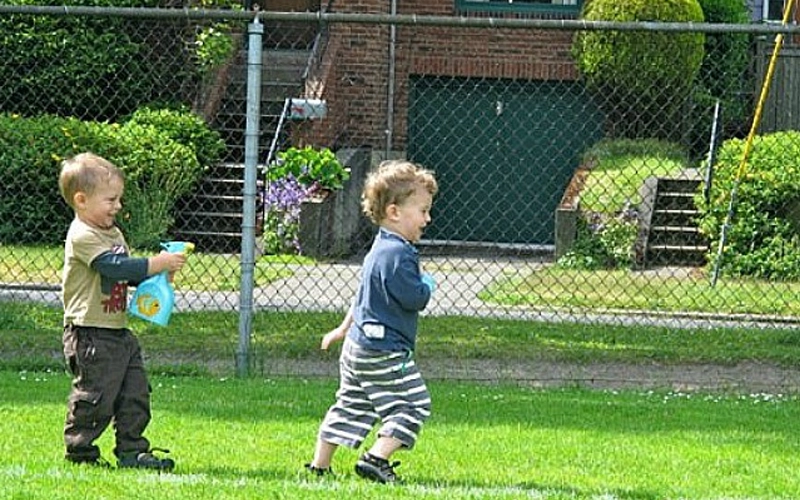
Online Indoor Recess Games
In today’s digital age, online indoor recess games are a fantastic way to keep preschoolers, kindergarteners, and early learners engaged while integrating technology into their daily routines. These games combine fun and education, providing an interactive way to learn, move, and play, especially when indoor physical activities are impossible.
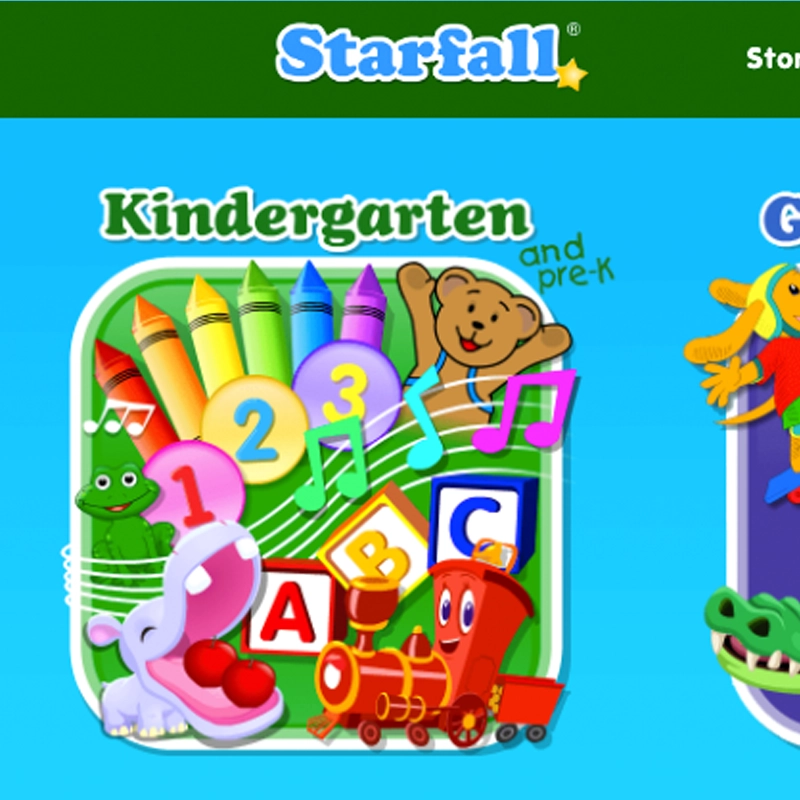
1. GoNoodle
GoNoodle offers a variety of interactive, movement-based videos that help kids release energy during indoor recess. The videos encourage children to dance, stretch, and follow along with fun, animated characters. This platform is widely used in preschool and kindergarten classrooms to get kids moving and having fun while staying active indoors.
2. ABCmouse
ABCmouse is an online learning platform that offers a variety of educational games, puzzles, and activities for preschoolers and kindergarteners. It includes math, reading, and science games, making it a perfect indoor recess game for young learners who want to practice their academic skills while having fun.

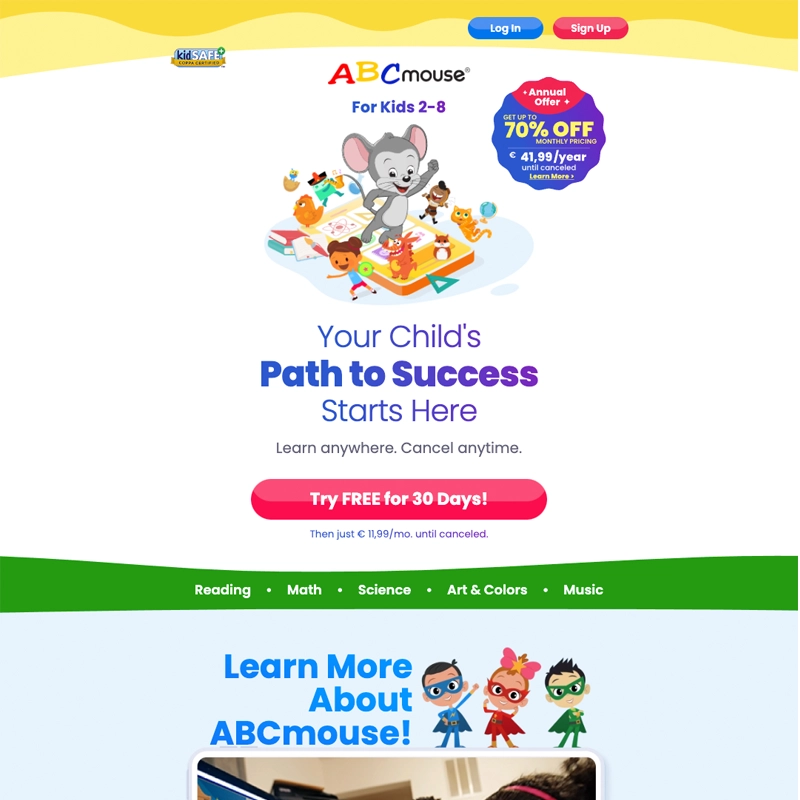
3. Starfall
Starfall is a popular educational website that teaches children to read and write through interactive games and activities. It’s an excellent option for kindergarten and preschool children who need help with early literacy skills. Starfall provides a fun and engaging way to practice phonics, letters, and simple vocabulary during indoor recess.
4. Cosmic Kids Yoga
Cosmic Kids Yoga offers online yoga sessions designed specifically for young children. These guided sessions teach basic yoga poses through fun stories and adventures, helping children improve their balance, flexibility, and focus. Cosmic Kids Yoga is a great way to combine relaxation and physical activity during indoor recess.
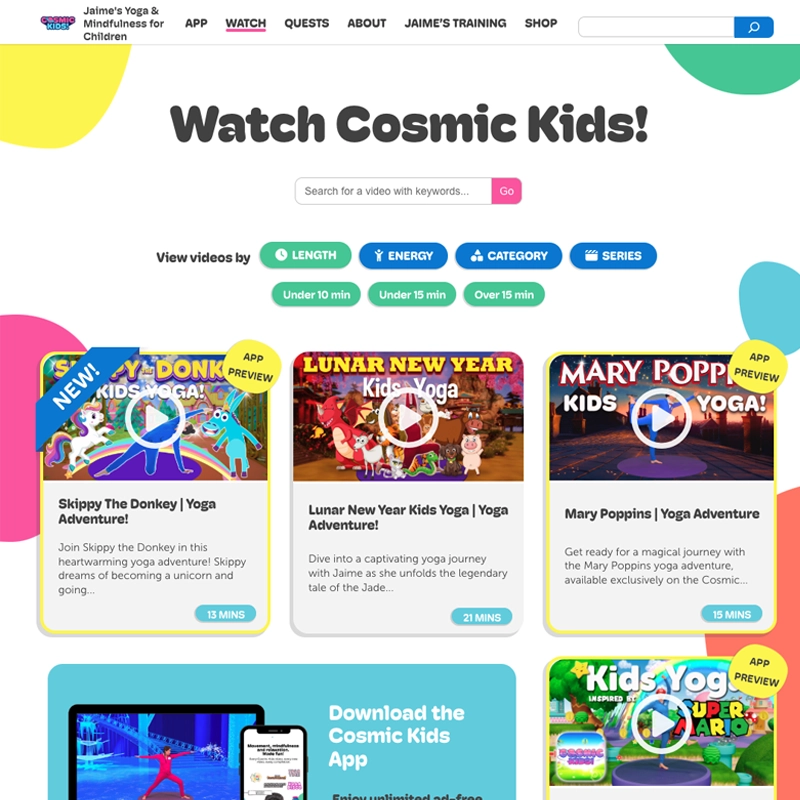
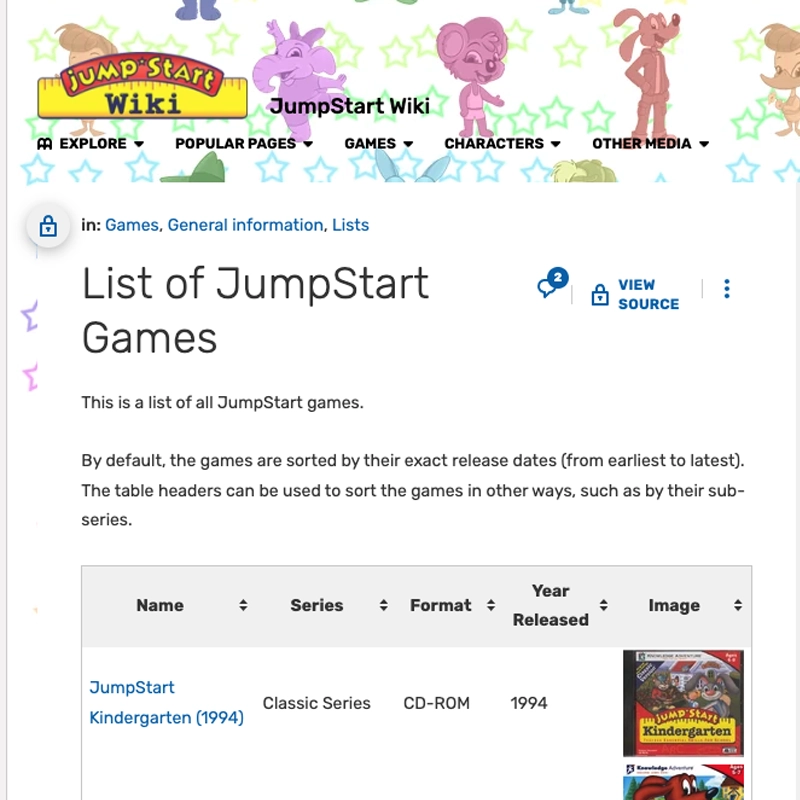
5. JumpStart Games
JumpStart Games offers a variety of interactive games designed to teach children essential academic skills such as math, reading, and problem-solving. It’s a perfect option for indoor recess in kindergarten and preschool settings, providing fun and educational content that keeps children entertained while learning.
These online indoor recess games provide a fun and educational way for preschoolers, kindergarteners, and young learners to engage with technology while enjoying their break time. They are an excellent complement to physical indoor games, balancing active play and academic learning.
Indoor Recess Games for Elementary School
| Grade | Games |
|---|---|
| 1st Graders | – Musical Chairs: Walk around chairs while music plays. When the music stops, quickly find a seat. |
| – Pin the Tail on the Donkey: Blindfolded children try to pin the tail on the donkey (or other themed characters). | |
| – Hot Potato: Pass an object around while music plays. When the music stops, the child holding the object is out. | |
| 3rd & 4th Graders | – Chutes and Ladders: A board game where children move forward based on dice rolls, but can slide backward if they land on a chute. |
| – Monopoly Jr.: A simplified version of Monopoly that helps children practice counting money and basic strategy. | |
| – Uno: A fast-paced card game teaching number recognition, strategy, and color matching. | |
| 5th Graders | – Pictionary: A drawing and guessing game where children draw pictures to represent words, and others guess the word. |
| – Tic-Tac-Toe: A strategy game where children aim to get three in a row by planning ahead. | |
| – Hangman: A word-guessing game where players try to guess letters to complete a word. |
By adjusting these games for the elementary school age group, we ensure that each game is appropriate for the cognitive and social development of the children at these different grade levels. These games are fun and help with skill-building in problem-solving, teamwork, strategy, and communication, making indoor recess an enriching experience for elementary school kids.
How Can Indoor Recess Be Both Fun and Educational?
Indoor recess is not just a time for children to release energy; it can also be a valuable learning opportunity. By incorporating indoor recess games that are both fun and educational, teachers can enhance students’ development while ensuring they stay active and engaged. Here are a few ideas on how to make indoor recess both enjoyable and educational:
- Trivia Games Related to Classroom Topics
One way to make indoor recess games educational is to tie them to the subjects studied in class. Teachers can use trivia games related to math, science, language arts, or history to make learning fun. For example, they can use questions from subjects studied in class to hold a fun and educational trivia contest. This helps children retain what they are learning while adding a competitive and interactive element to indoor recess. - Story Prompts
Another educational game for indoor recess is using story prompts. Ask kids to write short stories based on creative prompts. This activity allows children to practice their writing skills while engaging their imagination. Not only does it help them develop literacy and writing skills, but it also gives children the freedom to express their creativity during indoor recess. It’s a great way to combine fun and educational elements in a single activity. - Origami Challenges
Origami challenges are perfect for indoor recess games, promoting creativity and fine motor skills. Teachers can teach kids simple origami projects, such as making paper cranes or boats. These activities engage children’s minds while developing their hand-eye coordination and fine motor skills. Incorporating origami into indoor recess allows kids to be creative while improving their dexterity and focus—two essential skills for their academic and personal development.
How Can Teachers Ensure Indoor Recess is Safe and Controlled?
Ensuring that indoor recess games are safe and controlled is essential for creating a positive and secure learning environment. While recess is a time for kids to be active, the games must be supervised and designed with safety in mind. Here are some strategies teachers can use to ensure indoor recess is both fun and safe:
Supervision and Clear Rules
Establishing clear guidelines and rules for each indoor recess game is crucial to ensure safety. Teachers should set expectations for each game and communicate these rules to the students before they begin. Clear instructions and supervision help prevent accidents and ensure children stay safe while playing. Having supervision ensures that indoor recess remains enjoyable while minimizing the risk of injuries.
Limit Physical Contact
When selecting indoor recess games for large groups, it’s essential to prioritize non-contact activities to minimize the risk of injury. Games like Simon Says, Freeze Dance, or Balloon Pop Relay are ideal for this because they allow children to stay active and engaged without physical contact. Limiting physical contact is especially important in confined spaces where accidents are more likely to occur. Teachers can ensure that games are safe by choosing those that do not involve direct contact between students.
Create Safe Play Zones
Teachers can create specific play zones within the classroom or indoor space to keep indoor recess organized and safe. These zones should be marked for different activities, ensuring children aren’t running or bumping into each other while playing. For example, create a zone for ball toss games, another for puzzles or board games, and a space for movement activities like Freeze Dance. This organization helps keep children in their designated areas, reducing the chances of accidents and ensuring a smooth, controlled indoor recess experience.
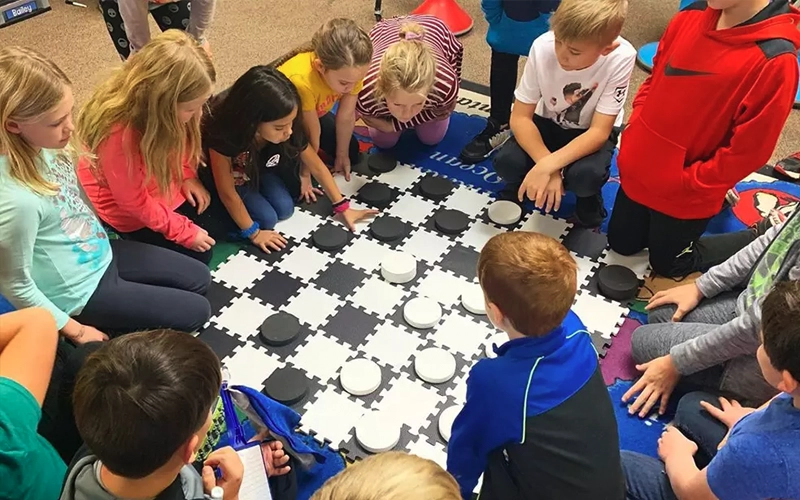
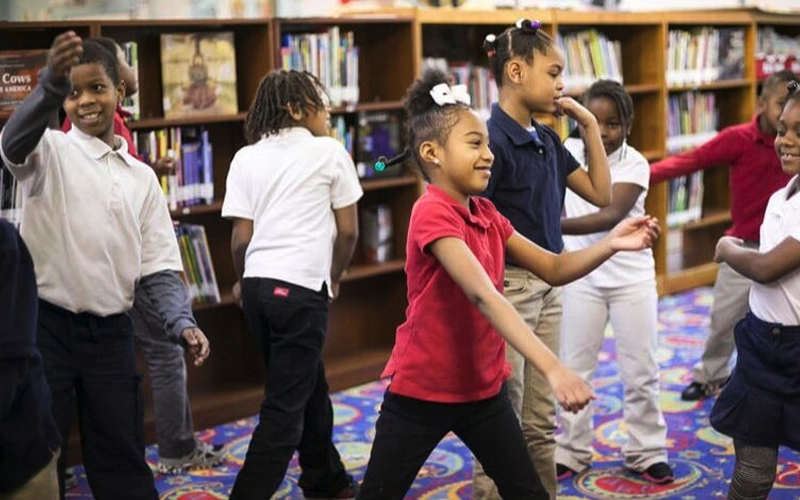
Conclusione
In conclusion, indoor recess games are a crucial component of a child’s day, providing more than just a break from learning. When thoughtfully selected, these games can enhance children’s physical, social, and cognitive development while giving them a fun and engaging way to relax and recharge. From simple and active games like Simon Says to educational challenges like story prompts and origami, indoor recess offers endless opportunities for learning and growth.
Teachers need to balance fun and education during indoor recess to ensure that children are entertained and develop essential skills that will benefit them both in and out of the classroom. Proper supervision, clear rules, and well-chosen games can help teachers create a safe and controlled environment where children thrive.
By incorporating a variety of indoor recess games, from active and creative activities to educational challenges and even online games, teachers can meet the diverse needs of students. Whether in kindergarten, preschool, or elementary school, these activities contribute to a well-rounded educational experience that supports every child’s growth. Indoor recess is not just a break—it’s a valuable tool for helping children develop essential life skills in a fun, engaging, and supportive environment.
Domande frequenti
What are some easy indoor recess games for rainy days?
Games like Simon Says or Freeze Dance is easy to set up and require little space or equipment. These games are perfect for rainy days because they can be played in small spaces and don’t need much preparation. Simon Says is great for developing listening skills and physical coordination, while Freeze Dance encourages movement and balance.
Can indoor recess games be educational?
You can use trivia, storytelling, or math-based games to make indoor recess fun while promoting learning. Trivia games related to classroom topics, such as math or language arts, are a great way to reinforce what children are learning in class. Story prompts can also help children practice their writing skills, turning indoor recess into an educational activity while keeping it fun.
How can I organize a safe indoor recess?
Set clear rules, monitor play closely, and select low-risk games like puzzles, trivia, or card games. Ensure that the activities are appropriate for the children’s age and space, and choose games that minimize risk, such as board games or non-contact activities. Keeping a close eye on the children during indoor recess will help prevent accidents.
What are some quiet indoor activities for shy kids?
Quiet games like card games, origami, or puzzles are perfect for shy children who prefer calm activities. These indoor recess games are great for kids who might feel overwhelmed by extensive group activities. Games that involve minimal interaction, such as puzzle games or solo crafts, give children a peaceful space to express their creativity.
Are there indoor recess games for large classrooms?
Yes! Games like Four Corners, Freeze Tag, and Indoor Volleyball can easily accommodate large groups of students. These games require minimal equipment and are great for helping large groups of children stay active. Four Corners is a fantastic option for bigger spaces, as it encourages movement while allowing kids to stay in a controlled environment.
Why is recess essential for kids’ social development?
Recess provides a space for kids to practice teamwork, resolve conflicts, and develop communication skills. Indoor recess games like group activities help children learn to collaborate, share, and negotiate with their peers, essential life skills. Social skills are just as critical as academic skills, and indoor recess allows children to practice these abilities in a relaxed setting.

